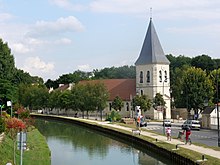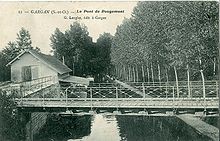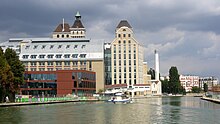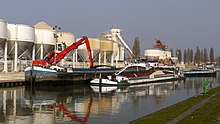Canal de l'Ourcq
The Canal de l'Ourcq is a French shipping canal that runs through the Aisne , Oise , Seine-et-Marne , Seine-Saint-Denis and Paris departments .
course


It begins in the small village of Port-aux-Perches, in the municipality of Silly-la-Poterie , from where the Ourcq river was canalized to accommodate shipping. 11 kilometers further, at Mareuil-sur-Ourcq , the canal branches off as an independent structure and follows the river as a side canal , on its right bank, to Lizy-sur-Ourcq , where the river joins the Marne . From here the canal accompanies the Marne on the right bank and changes at Fresnes-sur-Marne for a short distance into the valley of the Beuvronne . Soon after, the canal already reaches the northeastern suburbs of Paris and finally ends in the 19th arrondissement , where it joins the Bassin de la Villette . Here it is also connected to the other two Parisian canals: the Canal Saint-Martin and the Canal Saint-Denis .
Coordinates
- Starting point of the canal: 49 ° 11 '36 " N , 3 ° 9' 54" E
- End point of the canal: 48 ° 53 ′ 17 " N , 2 ° 22 ′ 43" E
technical infrastructure
The canal is 108 kilometers long and has 10 locks that overcome a height difference of around 14 meters. The locks on the canalized Ourcq are 62 × 5.20 meters. The largest part of the canal, namely from Mareuil-sur-Ourcq to Pavillon-sous-Bois (about 86 kilometers) is known as the "narrow canal" because its lock dimensions were originally only 58.88 × 3.20 meters. Most of these locks have already been converted to dimensions of 58.88 × 5.20 meters, only the Varreddes lock is still unchanged. This section of the canal can therefore still only be navigated with special types of boats ( Flûte de l'Ourcq ) or small sport boats. The remaining 11 kilometers in the direction of Paris city center do not require any locks, but have been developed for large shipping and can be used by cargo ships with a loading capacity of up to 1000 tons. Such ships can access the canal from the Seine using the Canal Saint-Denis .
The water supply of the canal was originally problematic and was changed several times through various additions and conversions. It is done by
- the river Ourcq itself,
- the river Clignon , via the Canal du Clignon built in 1839–1841 ,
- the river Marne, built in the 1860s, partly with steam and partly hydraulically operated water lifts in Trilbardou and Villiers-les-Rigault . Today they are historical monuments and have been operationally replaced by electric pumping stations.
- the river Beuvronne.
history

At the beginning of the 19th century, on the initiative of Napoléon I, the Ourcq river was partially diverted behind the town of Silly-la-Poterie, not far from the Forêt de Retz forest , and turned into a navigable waterway. The engineers Pierre-Simon Girard and Marie-Emile Vuigner carried out the construction. Work began in 1805 and was completed in 1822. The reason for the construction was the need for drinking water in the city of Paris, but the canal was also used to transport goods. The transport of goods, especially timber and firewood from the Retz forest , as well as coal from the mines in northern France, soon transformed the Bassin de La Villette into a large transshipment and storage area, which has preserved some of its warehouses to this day . In 1880 the canal was connected to the Marne by a boat lift , the Beauval inclined elevator . But this is no longer preserved.
Economical meaning

Today the canal no longer has any economic significance. Only its banks and towpaths serve the Parisians as a recreational area . However, there are efforts to make the canal more attractive for water tourism with pleasure boats, houseboats and excursion boats. For this reason, the existing lock dimensions are gradually being expanded. There are also plans to re-establish a navigable connection with the Marne at Lizy-sur-Ourcq.
Places on the canal
- Silly-la-Poterie
- La Ferté-Milon
- Mareuil-sur-Ourcq
- Neufchelles
- Crouy-sur-Ourcq
- Lizy-sur-Ourcq
- Congis-sur-Thérouanne
- Varreddes
- Meaux
- Fresnes-sur-Marne
- Claye-Souilly
- Paris


